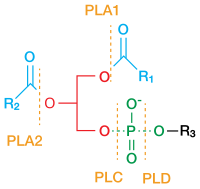
Synthesis and biological evaluation of novel oleanolic acid analogues as potential α-glucosidase inhibitors.
Sign Up to like & getrecommendations! Published in 2019 at "European journal of medicinal chemistry"
DOI: 10.1016/j.ejmech.2018.12.046
Abstract: Considerable interest has been attracted in oleanolic acid and its analogues because of their hypoglycemic activity. In this study, a series of novel oleanolic acid analogues against α-glucosidase were synthesized and their biological activities were… read more here.
Keywords: novel oleanolic; evaluation; glucosidase; oleanolic acid ... See more keywords

Interaction of salicylic acid analogues with Pluronic® micelles: Investigations on micellar growth and morphological transition
Sign Up to like & getrecommendations! Published in 2019 at "Journal of Molecular Liquids"
DOI: 10.1016/j.molliq.2018.12.142
Abstract: Abstract The aqueous solutions of PEO-PPO-PEO type triblock copolymers (Pluronic® P123, P103 and P105) with variations in their total molecular weight and block contribution are investigated for encapsulation of drugs. Two drugs, namely Aspirin (AS)… read more here.
Keywords: acid analogues; growth; micellar growth; interaction salicylic ... See more keywords

Glycoamino Acid Analogues of the Thomsen–Friedenreich Tumor-Associated Carbohydrate Antigen: Synthesis and Evaluation of Novel Antiproliferative Factor Glycopeptides
Sign Up to like & getrecommendations! Published in 2017 at "ACS Omega"
DOI: 10.1021/acsomega.7b01018
Abstract: Glycoamino acid analogues of the Thomsen–Friedenreich antigen disaccharide, where the 4′ and 4″ hydroxyl groups were substituted with fluorine or hydrogen, were synthesized and incorporated into the asialylated antiproliferative factor (as-APF), a biologically active form… read more here.
Keywords: antiproliferative factor; glycoamino acid; thomsen friedenreich; antigen ... See more keywords

A New Generation of Arachidonic Acid Analogues as Potential Neurological Agent Targeting Cytosolic Phospholipase A2
Sign Up to like & getrecommendations! Published in 2017 at "Scientific Reports"
DOI: 10.1038/s41598-017-13996-8
Abstract: Cytosolic phospholipase A2 (cPLA2) is an enzyme that releases arachidonic acid (AA) for the synthesis of eicosanoids and lysophospholipids which play critical roles in the initiation and modulation of oxidative stress and neuroinflammation. In the… read more here.
Keywords: new generation; arachidonic acid; cytosolic phospholipase; acid analogues ... See more keywords

Molecular dynamics of sialic acid analogues complex with cholera toxin and DFT optimization of ethylene glycol-mediated zinc nanocluster conjugation
Sign Up to like & getrecommendations! Published in 2017 at "Journal of Biomolecular Structure and Dynamics"
DOI: 10.1080/07391102.2015.1136689
Abstract: Cholera is an infectious disease caused by cholera toxin (CT) protein of bacterium Vibrio cholerae. A sequence of sialic acid (N-acetylneuraminic acid, NeuNAc or Neu5Ac) analogues modified in its C-5 position is modelled using molecular… read more here.
Keywords: molecular dynamics; cholera; neunac analogues; sialic acid ... See more keywords

Natural products-based: Synthesis and antifungal activity evaluation of novel L-pyroglutamic acid analogues
Sign Up to like & getrecommendations! Published in 2022 at "Frontiers in Plant Science"
DOI: 10.3389/fpls.2022.1102411
Abstract: Botanical pesticides are one of the sources of third-generation pesticides, which have received much attention at home and abroad in recent years due to their degradable and pollution-free advantages in nature. This article explored a… read more here.
Keywords: antifungal activity; activity; novel pyroglutamic; acid analogues ... See more keywords

Targeting Myeloperoxidase Activity and Neutrophil ROS Production to Modulate Redox Process: Effect of Ellagic Acid and Analogues
Sign Up to like & getrecommendations! Published in 2023 at "Molecules"
DOI: 10.3390/molecules28114516
Abstract: Malaria is an infectious disease caused by a Plasmodium genus parasite that remains the most widespread parasitosis. The spread of Plasmodium clones that are increasingly resistant to antimalarial molecules is a serious public health problem… read more here.
Keywords: effect; activity; ellagic acid; myeloperoxidase ... See more keywords